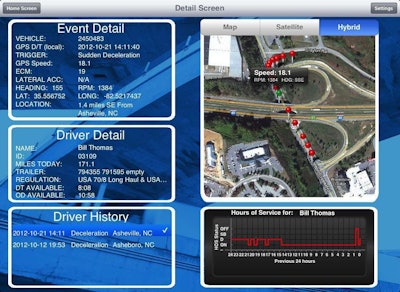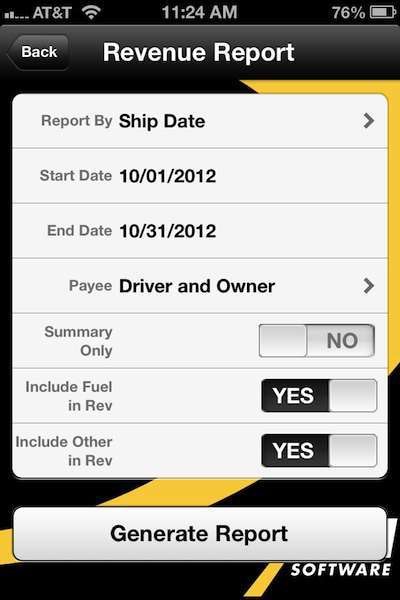 To use PeopleNet’s EventAlerter app, customers buy the company’s Trip Recorder software that runs on its in-cab devices. When a critical safety event occurs, a notification is sent immediately to a mobile device.
To use PeopleNet’s EventAlerter app, customers buy the company’s Trip Recorder software that runs on its in-cab devices. When a critical safety event occurs, a notification is sent immediately to a mobile device.The transportation industry is replete with fleet management systems that automate the flow of information between the office and vehicles. From a driver’s perspective, the latest advancements in mobile computing give them a more intuitive and structured workflow.
On the opposite side of the spectrum, fleet executives and managers have complex and dynamic information needs. Their work changes constantly, and like drivers, they are frequently on the go. Companies that develop fleet management systems are creating new options for mobile fleet executives to run their businesses from a smartphone or tablet.
Many fleet management systems already use a cloud computing model that makes it possible to access the software from any device with an Internet connection. Software developers now are taking fleet management to the next level of mobility with apps for smartphones and tablets. With these apps, users can get information faster, in a more consumable format, to make decisions quickly and respond to immediate events.
Enterprise apps
McLeod Software has developed mobile apps for the Apple iOS and Android platforms. The apps are designed to replicate the same functions and reports in McLeod’s LoadMaster and PowerBroker enterprise software systems for asset and nonasset transportation companies.
 McLeod Software’s mobile apps are designed to replicate the same functions and reports in the company’s LoadMaster and PowerBroker enterprise software systems for asset and nonasset transportation companies.
McLeod Software’s mobile apps are designed to replicate the same functions and reports in the company’s LoadMaster and PowerBroker enterprise software systems for asset and nonasset transportation companies.The advantage of using a mobile app to access information in LoadMaster or PowerBroker, as opposed to using a Web browser, is that an app is “with you all the time,” says Mack Killough, programming manager for McLeod Software.
“No matter where you are or what time of day, you are connected to it already,” Killough says. Users can view numerous up-to-the-minute reports and have custom exception alerts pushed to their smartphone or tablet through McLeod’s Rapid Alert Notification System module.
McLeod has added many new features to the mobile apps since it first introduced the product in 2010. To date, users have not been able to enter information, but that will change this year as the company plans to add full dispatch functionality and the ability to update records.
To use the apps, customers purchase a Web service that runs on a local server. The service allows the apps to access information from the database that is organized for presentation on mobile devices. Users can download the app to as many devices as they want for no extra charge.
Onboard apps
PeopleNet, a provider of integrated onboard computing and mobile communication systems, last year announced its EventAlerter mobile app designed to give mobile fleet executives “the information you need, when you need it, whether you knew you needed it or not,” says Randy Boyle, PeopleNet’s senior vice president of Tailored Solutions.
EventAlerter is available for the iPhone and iPad and a few Android devices. To use the app, customers buy PeopleNet’s Trip Recorder software that runs the company’s in-cab devices. When a critical safety event occurs – such as a sudden acceleration or deceleration, or activation of the vehicle’s rollover-stability control system – Trip Recorder posts the event details to a server.
A push notification then is sent immediately to the mobile device. From within the app, the user can access all relevant event data such as the driver’s identity, a satellite map view of the incident, time, speed, heading, miles driven today and the driver’s available hours of service. The event details also include pre- and post-incident trails and the last five safety events to assess the emergence of a negative trend.
Telogis’ new Fleet 10 management system includes a mobile app that allows field supervisors to access information about their teams in the field. The app is designed to help supervisors make quicker decisions throughout the day based on location and vehicle information as plans and needs evolve.
Telogis Supervisor is location-aware, allowing it to show the user where they are in relation to other vehicles and assets within their organizations. The app also shows customer information, driver data, recent stops and histories, as well as the vehicle that may be nearest to a specific job.
With the latest mobile apps, all it takes is a few screen taps to maintain real-time visibility and control of fleet operations while on the go.











